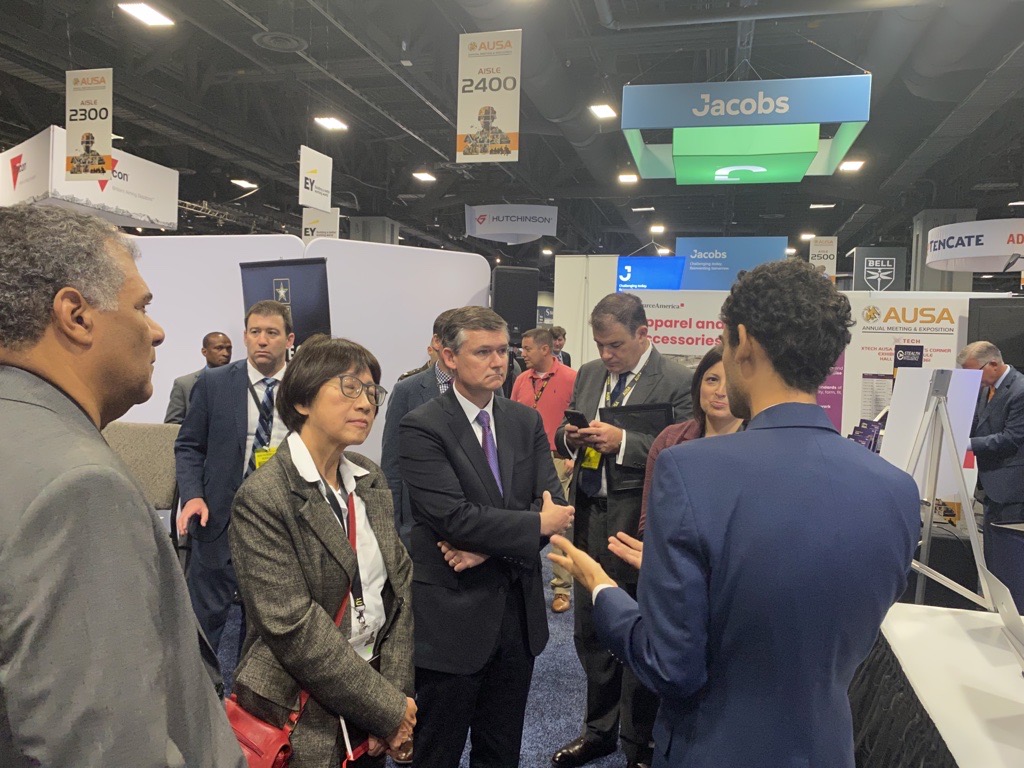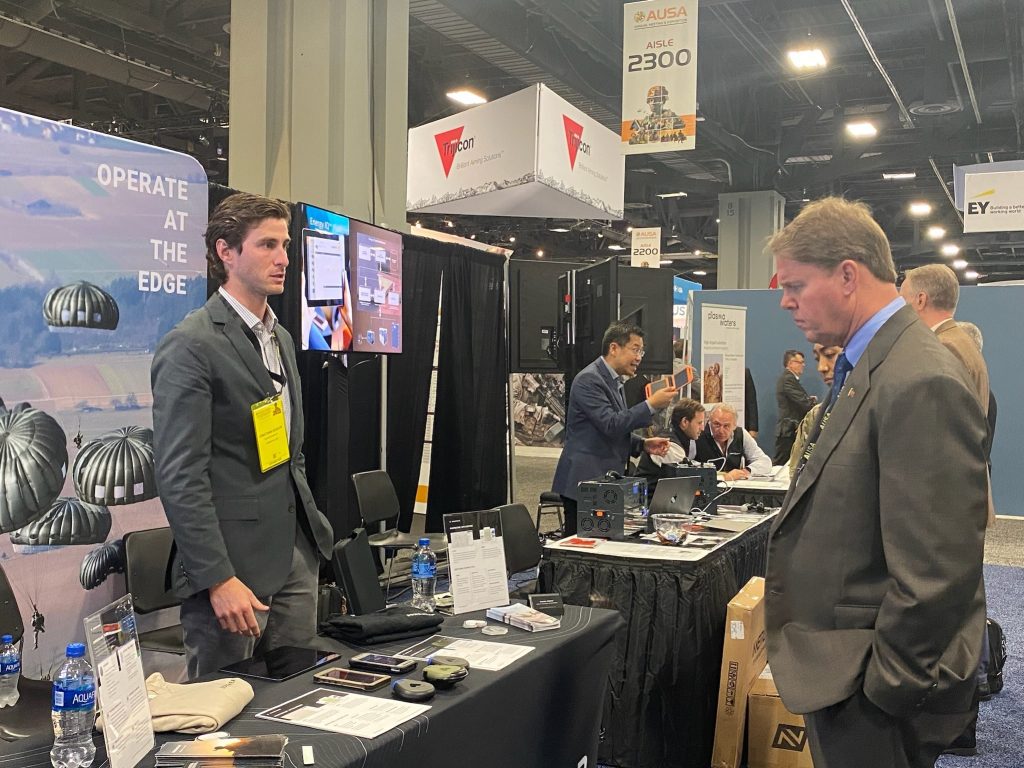
DOUBLE THE FUN: Douglas Bush, assistant secretary of the Army for acquisition, logistics and technology, left, talks with Shannon Sentell, Ph.D., COO of Stealth Power. The business was announced as a two-time xTech winner in 2022, in both the xTechSearch 6 and xTechSBIR Clean Tech competitions.
Army SBIR and xTech programs have a track record of sparking innovation, with ASA(ALT) serving as catalysts and drivers of the Army’s modernization efforts.
by Anna Volkwine and Daniel Smoot
The U.S. Army xTech and Army Applied Small Business and Innovation Research (SBIR) programs inject small businesses and nontraditional innovators into the Army ecosystem with capabilities that will serve as catalysts of innovation for the future force.
The xTech Program connects the Army with innovative businesses through prize competitions. Meanwhile, the congressionally funded SBIR program is a competitive, contract awards-based program that enables small businesses to interact with Soldiers and Army experts to solve various technological challenges. Both are sponsored by the assistant secretary of the Army for acquisition, logistics and technology (ASA(ALT)).
“The strength of our nation relies on a robust commercial economy comprised of small businesses and nontraditionals that are ready, willing and able to help us build an enduring advantage,” said Matthew Willis, Ph.D., director of Army Prize Competitions and the Army Applied SBIR Program, within the Office of ASA(ALT).
The programs will help build the future Army through three new efforts: the SBIR CATALYST Program, the xTechPrime Competition and the Army Research and Development (R&D) Marketplace.
The Army of 2030, with leadership from ASA(ALT) initiatives, will ignite transitional speed behind solutions from critical drivers that can close complex capability gaps for Soldiers and bolster national security.
These cooperative endeavors will align solutions from innovators with the most complex Army challenges. They also will drive higher funding and streamlined partnerships with prime contractors and greater transparency among Army stakeholders.
The SBIR CATALYST Program, xTechPrime Competition and R&D Marketplace will play key roles in helping build the Army of 2030. While using different mechanisms to innovation, the initiatives will be synchronized to capitalize on existing focus and funding in the discovery and delivery of critical, next-generation technologies.
ARMY SBIR CATALYST PROGRAM
ASA(ALT) will launch a pilot of the Army SBIR CATALYST Program this spring to drive and incentivize collaboration and to spur investment in science and technology-based small businesses. Through the program, the Army will direct 15 percent of Army SBIR’s $300 million annual budget to offer up to five awards and, in 2023, to enhance technological exploration, development and Army priorities.
The SBIR CATALYST Program also intends to tackle existing transition risks for SBIR prototypes by focusing on technology solicitations in key Army areas including sensors; climate and clean technology; artificial intelligence and machine learning; and immersive and wearables.
The SBIR CATALYST Program will increase potential funding by requiring matching funds from the Army SBIR Program, Army customers and defense contractors. Meanwhile, the standard Army SBIR Program will continue to release R&D solicitations on an ad hoc basis.
This effort could drive scientific and technical growth by enabling the Army to increase its appeal as a partner to small businesses—the SBIR CATALYST Program may lift contract award funding up to eight times larger than the standard SBIR contract, with awards as high as $15 million to $20 million, to support more scalable R&D acquisitions.
“To facilitate scientific advancement, the SBIR CATALYST Program will strengthen the alignment of technology exploration and development, synergize Army investments with integrators, and drive down transition risk,” Willis said.

EYES ON THE PRIZE: Heidi Shyu, undersecretary of defense for research and engineering, left center, and Army Acquisition Executive Douglas Bush, right center, speak with Austin Murdock, Ph.D., the CEO of SixMap Inc., an xTechSearch 6 winner, at the xTech Innovator’s Corner during the 2022 Association of the United States Annual Meeting and Exposition in Washington. (Photos by U.S. Army xTech Program)
XTECHPRIME COMPETITION
The ASA(ALT)-led Army xTech Program offers several science and technology prize competitions throughout the year to attract innovators such as small businesses, academia and international industry leaders with dual-use solutions. Since its start in 2018, the program has awarded over $17.6 million in cash prizes and $89.4 million in follow-on contracts to those with novel technologies that solve the Army’s most critical modernization needs.
Launching in 2023, the xTechPrime competition will continue this trend and build on xTech’s competition and cash prizes with a new program structure. It will require prime contractors to partner with small businesses to improve inclusivity, and link businesses directly with the Army innovation and acquisition enterprise.
This will foster collaboration between these two critical sources of innovation, while also increasing the likelihood of contract awards. Prime defense contractors bring multiple benefits to the table that help smaller companies with less funding and fewer connections. These advantages range from experience in early-stage business development, prototyping, marketing, Army relations and navigating the Army acquisition process.
In addition to cash prizes, both small businesses and large integrators will be eligible for follow-on SBIR contract awards—with the large integrators serving as subcontractors to their small-business partners on SBIR contracts.
Continuing this prime integrator and small-business partnership will help guide small businesses to where solutions fit into the Army landscape and clear a pathway for potential SBIR Phase III sole-source awards, which means a proposal no longer needs to compete with other companies to receive funding. As subcontractors, large integrators can continue serving in a mentorship role, while allowing the small businesses to spearhead their technology transition to the Army.
“Major weapons system prime contractors are essential partners in technology transitions,” Willis said. “We simply cannot succeed as an Army without them, which is why it is imperative that we deploy mechanisms that incentivize collaboration with small businesses.”
While the xTech prize competition offers a steady and dynamic rhythm of prize competitions throughout the year, xTechPrime’s unique formulation will ignite a new wave of collaboration in support of the nation’s Soldier.

FIRSTHAND KNOWLEDGE: Willie Nelson, deputy assistant secretary of the Army for research and technology, right, sees firsthand how the Army xTech and Army Applied Small Business Innovation Research Program are serving as catalysts for Army innovation as he talks with Jonathan Besquin of Somewear Labs Marketing Manager, winner and SBIR awardee from xTechSearch 6.
THE ARMY R&D MARKETPLACE
Over the course of 2023, the Army will develop an on-demand portal—the R&D Marketplace—that will connect the dots between multiple resources such as small businesses, prime contractors, Army programs and technology developers.
Connections made through the digital marketplace will give these businesses insight into existing companies and technologies, as well as potential collaboration opportunities with minimized transition risk and speedier innovation within the Army’s major weapon systems platforms.
Many moving pieces lead to a full-scale Army acquisition from a nontraditional vendor, whether it may be a small business or prime contractor. The R&D Marketplace will create greater awareness and transparency among key players that make acquisitions and technology transitions to the Soldier possible. This includes small- and large-scale technology innovators, Army leaders, program managers, program executive offices and laboratories.
“The Army R&D Marketplace is not just another customer relationship management tool,” Willis said. “The Army R&D Marketplace is unique among all existing DOD technology platforms, as it will rely on artificial intelligence and data fusion to assess technologies, identify trends and maximize the value of business intelligence data to support agile Army decision-making.”
|
ARMY PROGRAMS IGNITE QUICK-TURN CLEAN TECH The U.S. Army’s race toward the future of innovation runs alongside another sustainment challenge: The Army must identify energy-efficient technologies to curb the impacts of climate change. Several efforts establish the Army as a champion of clean tech while still equipping Soldiers with peak-performance solutions. In addition to the SBIR CATALYST Program’s clean-tech focus, the U.S. Army xTech Program also mitigates the Army’s environmental footprint in alignment with the Army Climate Strategy, which was released last year. “The Army has an operational footprint and a carbon trail,” said Matthew Willis, Ph.D., director of Army Prize Competitions and the Army Applied SBIR Program. “As a result, we need to invest in technologies that recognize this reality and reduce greenhouse gas emissions.” The xTechSBIR Clean Tech competition launched in April 2022 to support the Army Climate Strategy. It began with a call for small and nontraditional businesses to submit concept white papers on their novel, disruptive clean tech solutions. XTech received nearly 200 submissions for several Soldier-operative technologies that support the Army’s objectives to reduce greenhouse gas emissions. In July 2022—only three months after the launch of the competition—the program announced 24 winners, who each received $10,000 in cash prizes and the opportunity to submit for either a Phase I SBIR contract award of $250,000 or a Direct to Phase II SBIR contract award of $1.8 million. This combination of a quick-turn award and transition potential proves that Army mechanisms, such as xTech and SBIR, are responsive and proactive at the point of need. “The competition evaluated hundreds of clean technologies against their application to the Army Climate Strategy,” Willis said. “Not only were we able to identify the top 24 solutions, but the SBIR awards allow us to actually bring them on contract—and quickly—so the Army can deliver and deploy these technologies to Soldiers.” —ANNA VOLKWINE AND DANIEL SMOOT |
CONCLUSION
The Army SBIR and xTech Programs have a track record of sparking innovation, with ASA(ALT) serving as a catalyst and driver of the Army’s modernization efforts.
“These actions link to the National Defense Strategy to build a resilient joint force and defense ecosystem, so the industrial base is capable of both innovation and surge production,” Willis said. “They operationalize the secretary of the Army’s primary objective to put the Army on a sustainable strategic path to operate in contested environments and become more resilient in the face of climate change.”
The SBIR CATALYST Program, xTechPrime competition and R&D Marketplace will further evolve ASA(ALT)’s Army SBIR and xTech programs to be more adaptive and responsive to the needs of nontraditional companies and Army acquisition programs. This will not only strengthen the U.S. industrial base but also help to build the Army of 2030.
For more information on the Army Applied SBIR Program, go to https://www.armysbir.army.mil/. To learn more about xTech competitions, go to https://www.xtech.army.mil/.
ANNA VOLKWINE provides contract support to the U.S. Army Applied SBIR and xTech programs for Booz Allen Hamilton. She holds a B.A. in communications from Mount St. Mary’s University.
DANIEL SMOOT provides contract support to the U.S. Army Applied SBIR and xTech programs for Booz Allen Hamilton. He holds a B.S. in writing from Towson University.







